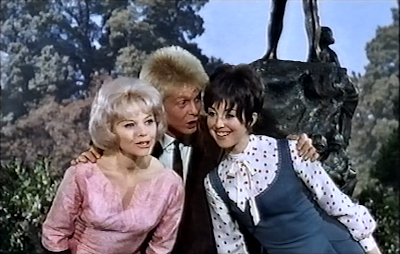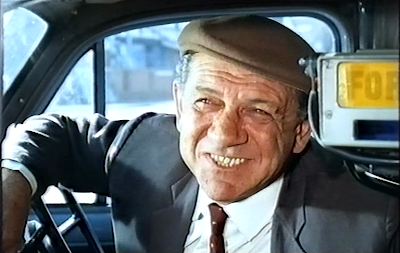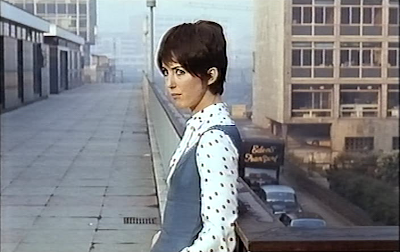Joe Brown went on to star in another film of which I am very fond, called Three Hats for Lisa. It's also set in London, but with no stage original that I know of, and songs not by Alan Klein but Newley collaborator Leslie Bricusse.
I have, on occasion, maintained that this is The Best Film Ever Made. But here, in the deep privacy of the unread blog, even I would have to admit that whatever the verve of the playing, we are veering more to Cliff Richard territory in the storyline (also by Bricusse, although the screenplay is by Talbot Rothwell). No pretentions to social criticism here, and the film is candyfloss-light and yet...
..
Well, it's partly the acting. Sid James is among the cast, a taxi driver suckered into ferrying besotted film fan Brown and his friends around London to steal various items of headgear at the whim of a visiting Italian starlet.
There's a lot of location filming - as well as some apalling studio backdrops, but it was a B movie.
As a celebration of Swinging London in 1966, it's remarkably staid, and yet that doesn't matter. It's an odd mix of fairytale and - well, not grit, exactly, but you willingly buy into the dream. The comedy is well handled (the cast also includes Eric Barker, below, and Peter Bowles) but nothing is played strictly for laughs. Hey, they're on a Vogler-approved quest. Sort of.
The main characters have bunked off work for the day and the whole thing feels - as Amis fils once said of the Royal Family - like a holiday from reason which does us no harm.
I don't know whether this poster was for the US or UK market but it sums it up:
The moment when the various hats have been acquired and the starlet, who has likewise bunked off from her promotional duties, goes back to her glamorous world is delicately handled.
Delicately and rather conveniently, because Joe Brown's character forsakes the opportunity for further contact with the object of his dreams (he was practically snogging the face off her cardboard cutout, below, at the start) by spurning the starlet's premiere in favour of seeing it when it comes to his local.
Which could be an "I-know-my-place" situation, but then, the sort-of serious side of the film has been about Joe Brown's character working through his fantasy about an unattainable woman and recognising the worth of his real girlfriend (Una Stubbs).
With a little paternal intervention from Sid, Lisa helps to win her over ...
... and Joe Brown's character does the rest.
Maybe what also appealed to me when I first saw it on TV around 1977 was the sense of London, a city I only knew through film, as a giant playground, and a mixture of the old and what was then brand spanking new (although time has now caught up with it: a building just out of shot of the above number, St Alphage House, where I worked in the mid eighties, is now due for demolition. And the yuppie sandwich bars which dotted the podium area then have long been but a distant dream.)
Needing to lay low, or rather high, thanks to Sid's obliging brother in law (Joe Gladwin) they even manage to wangle a visit to the as yet unopened Post Office Tower. And even that futuristic location is made homely when they have a fry-up in what will become the revolving restaurant - "Just don't set fire to the place, that's all I ask," is the lugubrious Gladwin's plea.
It's a long way from Brown's earlier film, What a Crazy World: more like What a Momentarily Ideal World in Which Even Policemen Obligingly Assist in One's Hattish Quest. But it does feel far less well scrubbed than a Cliff Richard vehicle - no pun intended - in large part down to Sid James.
Even the fairytale ending has a speck of grit. With his taxi wanted by the police, Sid is obliged to take out his old dad's horse and carriage (actually, let's gloss over why that should make the group less conspicuous) and when Joe Brown rejoins the carriage after making his sad farewells to Lisa, who has gone into the depths of the Hilton, it's suddenly a happy leavetaking when Sid discovers she has generously compensated him for the jaunt: "You're a lovely girl!" he shouts up at her window.
And then, with Lisa watching sadly from her window, the others go off in the carriage ...
... to be eventually swallowed up in the traffic, as though the whole thing was no more than a dream on both sides. There's a very syrupy closing song which nevertheless fits with the need to be brought down lightly from this fantasy:
One day in London, a miracle happened
The way that things in storybooks do ...
Brown has said he only did the film for an opportunity to work with Sid James, and it's James, who had been in the London production of Kiss Me Kate, who is given the plum song, the only number which might have fitted into What a Crazy World, an ode to Bermondsey which is equal parts Basin Street Blues and Flanagan and Allen's Hometown.
I can't say I've ever been a huge Joe Brown fan in the sense of buying lots of records but he's always been a comforting presence in the background: I recall fondly a song he sang about working on the railways, in some forgotten children's TV programme. Possibly even the programme below, such is the magic of the internet:
And I think he had actually worked as a railwayman for a time.Which helps explain, perhaps, what he has which which separates him from Bowie and Anthony Newley. In Halfway to Paradise, Newley speculates on why he was the one to make it big in America rather than, say, Tommy Steele or Bruce Forsyth. His eventual conclusion - as good as any - is "glitz". And glitz is something Joe Brown most definitely doesn't have, dating right back to the time Larry Parnes wanted to rechristen him Elmer Twitch. Joe Brown he was and has remained.
And songs such as I'm Henery the Eighth, far from being mere novelty numbers to cash in on a sixties craze, reach right back into his childhood living above a pub. (The Herman's Hermits version came a couple of years later and was aimed at the American market.) I heard him once on Brian Matthew's vanished Round Midnight show on Radio 2, astonished at hearing a recording of the song with a verse: he had only ever known it as a singalong chorus, and that was how he recorded it.
As many readers will know, his rendition of another old song, I'll See You in My Dreams, was one of the highlights of the concert for George Harrison at the Albert Hall. No histrionics, just the gentle caressing of the song's lyrics to his own uke accompaniment, and his love for an old friend beaming unmistakably through. (A star before the Beatles, Brown had headlined a tour with them in the early days, which perhaps explains how he had got under the Fabs' radar.)
I've often talked in this blog about my fascination with those who are - I was going to say condemned, but that isn't the right word - with those who choose, say, or feel they have no choice but to - play their old songs night after night to make a living. In the Spencer Leigh book, Brown seems to take it on the chin about the commercial failure of one cherished project, Brown's Home Brew:
I put my heart and soul into it [...] There are hundreds of people you can pass the buck to but it either sells or it doesn't, and that didn't.But he's still performing, still playing a mix of old and new:
I don't mind playing the old songs although it's hard to sing "Dad's gone down the dogtrack" now. If my dad were alive, he'd be 103.And he still has the capacity to delight. Looking through various youtube clips, I came across this one of his chatting to Jools Holland on Later and playing a bit of guitar alongside the host's piano. Now, how many times have you heard Whole Lotta Shakin'? But watching that, his evident enjoyment in playing and singing it gave me pleasure - reason enough to embed it below:
Part Four: What a Crazy World
Related post:
Was there a soundtrack LP for Three Hats For Lisa? here
Suggested links:
Full cast and crew credits on BFI site here.
Guardian obituary for cinematographer Alan Hume, who died this year, here; Independent obituary here.
Wikipedia page for director Sidney Hayers here.
Leslie Bricusse biography on his own website here.
Joe Brown official website here.
2007 Una Stubbs interview here
























No comments:
Post a Comment